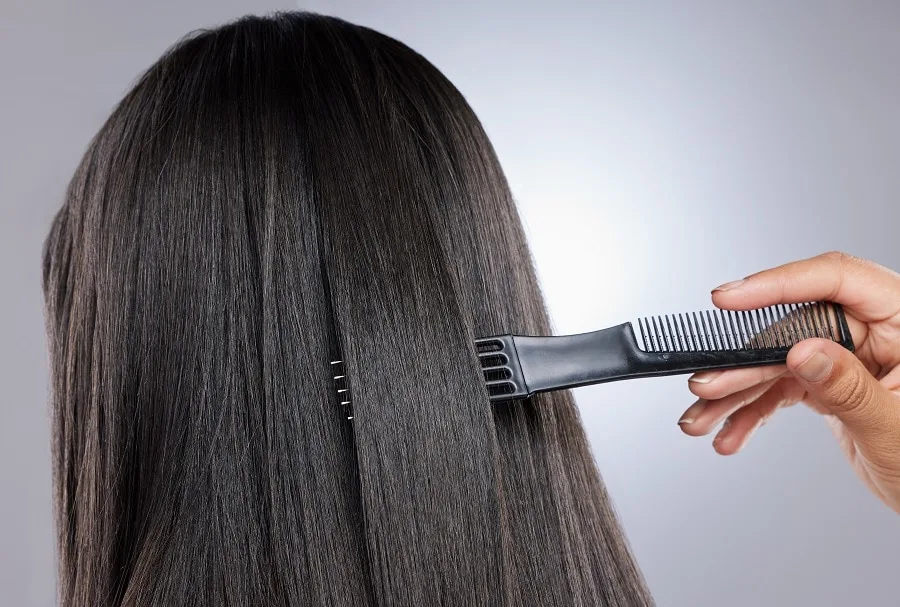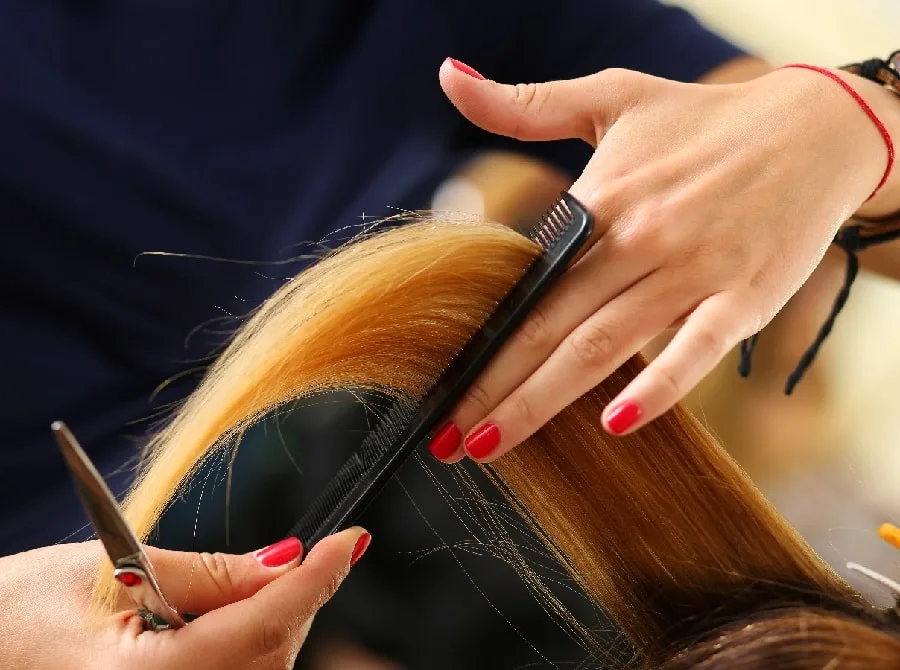Ever feel like your hair is growing crazy fast all of a sudden? You’re not imagining things! There are a few reasons why your hair might be growing faster than usual.
Several factors can affect your hair’s growth rate. Some of them are natural. Some aren’t. On the positive side, maybe you switched up your hair products or diet, which can definitely speed things up.
It can also indicate hormonal changes due to certain physical conditions. We’ll break down the possible causes behind your hair growing so fast and give tips to manage that excessive growth.
What Causes Hair to Grow Too Fast?

Hair growth rate is primarily influenced by genetics, but other factors like age, hormones, diet, scalp health, season, certain health conditions, medications, and stress levels can also play a role.
Understanding the potential reasons behind your hair’s rapid growth might help you know if there’s anything you can do about it. So, let’s get right to it!
Genetics
You can work that Sherlockian mind of yours to figure out why your hair grows so quickly, but the truth is that you might have genes that promote fast hair growth.
After all, your DNA controls every aspect of your appearance, from skin color and height to hair type.
Yes, it can even determine how fast your hair grows. If you have a parent with a rapid hair growth rate, you’ll probably have fast-growing hair, too.
Ethnicity

A study conducted in 2016, explores the influence of ethnicity on hair growth, showing how hair growth differs from one ethnic group to another.
The study concluded that subjects of African descent have slow-growing hair, while those of Asian descent have fast-growing hair. People of European descent stood in the middle.
Hormones
The fluctuating flow of Testosterone and DHEA (androgens) inside your body can affect your hair growth rate. While they’re known as male hormones, they exist within the female body as well.
The more androgens you produce, the faster your hair grows. That’s why pregnant women experience excess hair growth in different parts of their bodies.
The sudden increase in androgens and estrogen boosts the growth phase of the hair cycle and minimizes hair loss.
However, most of that excess hair falls after giving birth, as the estrogen and androgen levels return to normal.
Age
You probably know that as you get older, you start producing thinner hair at slower rates. But did you know that there’s a certain phase where you experience an increase in hair growth?
Between the ages of 15-30, your testosterone levels are at their highest, promoting rapid hair growth before slowing down.
Hair Thickness

This may come as a surprise, but hair thickness affects its growth rate. One study examined more than 50,000 subjects and concluded that people with thick hair experience faster growth than thin hair.
Unfortunately, thickness is hard to identify, as most people confuse it with density. There’s a simple way to examine your hair’s thickness, though. Grab a hair strand and roll it back and forth.
If it feels like a sewing thread, then you have thick hair, and you’ve determined why it grows so quickly.
Diet

This is the first factor on this list that you have control over. Your diet doesn’t just affect your weight and stamina. It can also affect your hair growth rate.
Food that’s high in zinc, iron, and niacin can encourage rapid hair growth. Frequently consuming eggs, fish, seeds, and spinach gives your hair enough vitamins and minerals to maintain a fast growth rate.
Some diets include oral supplements. These include vitamins A and C, which can promote hair growth.
Medical Condition
If your hair is growing unnaturally fast and you’ve eliminated all the previous factors, you might need to do some checkups.
Some medical conditions can change the flow of hormones in your body, causing excess hair growth. For example, PCOS increases the flow of androgens, promoting hair growth in different parts of the body.
Is Faster Hair Growth a Bad Sign?
Faster hair growth is not inherently bad. In fact, many people consider it desirable. However, rapid hair growth can sometimes be a sign of underlying health conditions, especially if accompanied by other symptoms.
Adult hair grows about half an inch per month on average. It’s not unusual to have a higher growth rate, in fact, hair can grow as long as 2 inches per month if you have the genetics or maintain a healthy routine.
But faster hair growth in unusual areas or due to conditions like hirsutism can be distressing. It might also mean more frequent hair maintenance is required.
It’s always a good idea to consult with a healthcare professional if there are sudden and unexplained changes in hair growth patterns.
But in most cases, faster hair growth is a natural variation and not a cause for concern. Faster hair growth may indicate one of the following:
- Hormonal Changes: Often seen during pregnancy or menopause.
- Medication Influence: Such as the effects of minoxidil (Rogaine).
- Effective Scalp Care: Including regular scalp massages.
- Optimal Nutrition: A diet rich in essential nutrients for hair health.
Rapid hair growth can be a blessing or a curse for you especially for styling your hair. The pros and cons depend on the individual preferences on how they want to style their hair.
Here are some of the benefits of faster hair growth:
- Allows for frequent changes and experimentation with hairstyles.
- Reduces the wait time to grow out a not-so-great haircut or hair damage.
- Fast-growing hair often appears more voluminous and full.
However, there are also some potential drawbacks to faster hair growth:
- May require more frequent haircuts or trims.
- Faster growth could lead to increased expenditure on hair products and salon visits.
- Extremely rapid and unexplained hair growth could be a symptom of certain medical conditions.
- Longer hair can sometimes be more challenging to manage, style, or keep healthy.
How to Manage Rapidly Growing Hair?
Managing fast hair growth is tedious—but not impossible. Some of these tips are complicated. Others aren’t. So, choose whichever you see fit.
1. Trimming

The most straightforward way to manage excess hair growth is to grab a pair of scissors and trim the ends. You can decide how much you need to cut yourself.
I know it’s overwhelming, especially if you’ve never cut hair before, but you can just cut one or two inches every few weeks.
If it’s necessary to thin out you go to a professional or you can also thin out your hair by yourself.
2. Shaving or Waxing
Luckily, there are various razors designed to remove body hair. They’re quick and efficient, but you may need to shave every week or two to maintain a clean appearance.
If that sounds like a hassle, waxing is more effective in removing hair for long periods of time but stay careful to prevent waxing wounds.
It’s crucial to note that frequent waxing can affect the nature of your hair, as it grows thinner than before. We recommend doing it every three weeks to avoid skin irritation.
3. New Hairstyle

As your hair grows faster it’s better to choose a new hairstyle. Some long hairstyles can help keep your fast-growing hair contained.
Layers are also your fast-growing hair’s bestie. They add shape and movement. A shag cut is perfect for disguising uneven growth with its many layers.
When you need a break from your hair party, braids, buns, and ponytails and braids, ponies have your back. Simply adjust them as your hair length changes.
And don’t sleep on undercuts! Shaving the sides and back reduces bulk while the top keeps growing. This opens up so many styling options.
You’ve got this! With the right cuts, you can outsmart rapid hair growth and look amazing.
4. Donations

If your hair grows excessively, why not donate some of it? You’d be keeping it at a moderate length and boosting a child’s confidence somewhere. Make sure to wash it thoroughly and refrain from using gel or mousse, and tie it in a ponytail.
5. Laser Removal
Laser hair removal, or electrolysis is effective for permanently removing body hair that is growing rapidly. The biggest selling point of laser hair removal is that it targets the roots.
Laser hair removal can significantly reduce hair growth. You can experience little to no hair regrowth for several months to years.
When hair does grow back, it’s typically finer and lighter in color. So you won’t have to worry about your hair growing back for years.
Summary
So, there are several variables like genetics, hormones, age, diet, medical conditions, etc. that increase your hair growth rate.
While some treatments might reduce hair growth temporarily, there’s no scientifically proven method to permanently alter natural hair growth rates.
Although it can be overwhelming to deal with, it gives you the chance to try different things to contain it. Choose a suitable hairstyle and consider trimming your fast-growing hair every 4-6 weeks.
